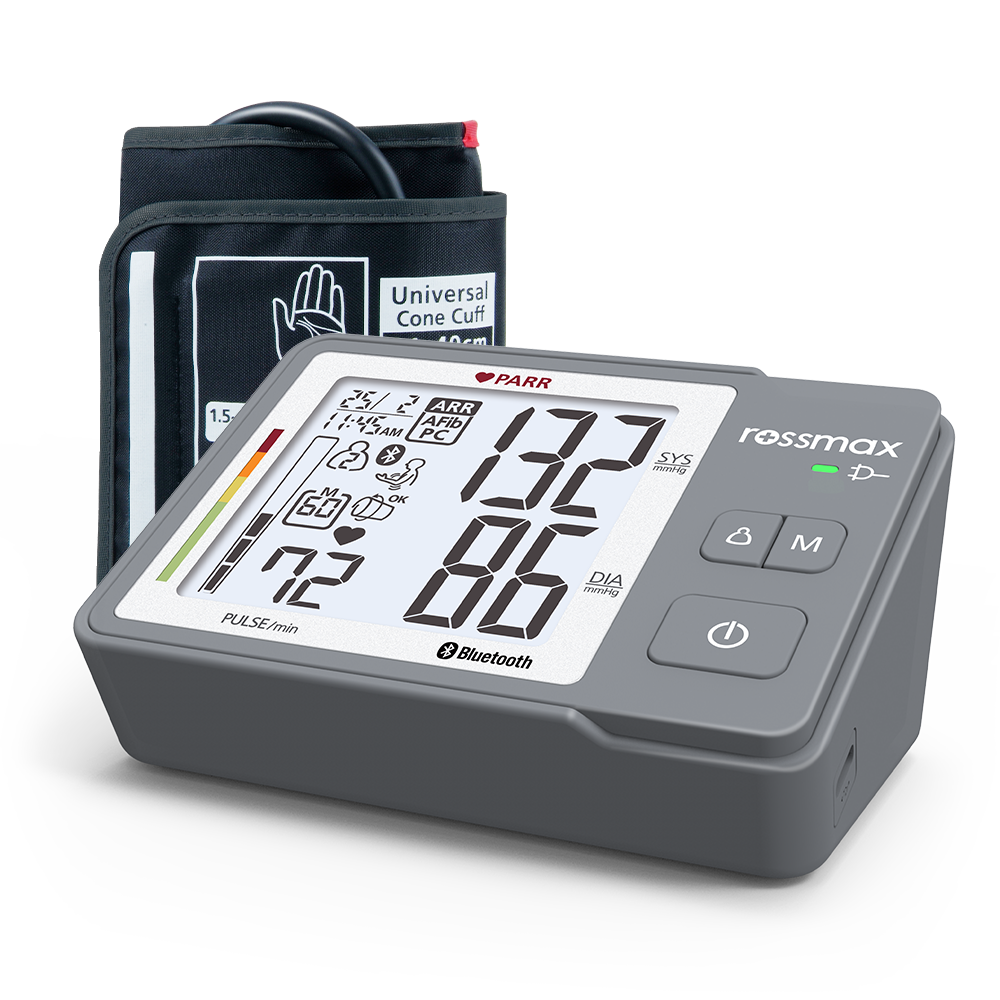High blood pressure and atrial fibrillation
increase the risk of cerebral infarction
A stroke often strikes completely unexpectedly
High blood pressure and atrial fibrillation increase the risk of cerebral infarction
Cerebral infarction refers to permanent damage to brain tissue caused by defective blood flow, or ischemia.
The cause of a cerebral infarction, or cerebrovascular accident, is a blockage of the cerebral arteries. Most often, the cause is a clot from the heart or carotid artery.
A stroke often strikes completely unexpectedly. Symptoms usually peak quickly, within minutes. Less often, it takes hours for symptoms to develop.

Rossmax Z5/X5 Blood Pressure Monitor
Detects arrhythmia in connection with quick and easy blood pressure measurement, and accurately distinguishes between atrial fibrillation and extra beats.
Symptoms of a suspected stroke
Cerebral infarction is not always self-recognized
Cerebral infarction may not even be recognized by yourself. Then it would be important to have another person nearby who can test for symptoms of a suspected stroke. If you suspect another cerebral infarction, ask the person:
-
raise arms (symptom of weakness or numbness of hands or feet)
-
repeat a simple sentence (symptom of slurred speech or difficulty speaking)
-
to smile (symptom of a hanging mouth game or a one-sided smile)
If the above functions cannot be performed by the person, the emergency number must be called immediately. In the case of a cerebral infarction, dissolution therapy should be initiated as soon as possible. The sooner treatment is started, the greater the benefits.
The hospital is the first to determine if there is a cerebral infarction, as cerebral infarction and cerebral hemorrhage can cause similar symptoms. With brain imaging studies, they can be distinguished from each other. In addition, other studies are being conducted to find out the cause of the stroke.
Momentary blockage of the brain artery
The TIA will pass in minutes
TIA (Transient Ischemic Attack), on the other hand, is a transient ischemic attack. A TIA is caused by a momentary blockage of an artery in the brain, for example as a result of a blood clot. The seizure usually lasts less than an hour, most typically 2 to 15 minutes, after which no permanent tissue damage is observed.
However, even during a TIA attack, it is important to get treatment immediately. Treatment should be sought immediately, even if symptoms persist.
The TIA should be taken seriously and the situation should be monitored particularly closely thereafter. Between 10 and 20 percent of those who receive their first TIA will have a stroke within three months of the attack. Up to half of these cerebral infarctions occur within two days of a TIA. The symptoms are usually sudden and are not accompanied by headaches or other symptoms. The recognizable symptoms are largely the same as in cerebral infarction:
The TIA should be taken seriously and the situation should be monitored particularly closely thereafter. Between 10 and 20 percent of those who receive their first TIA will have a stroke within three months of the attack. Up to half of these cerebral infarctions occur within two days of a TIA. The symptoms are usually sudden and are not accompanied by headaches or other symptoms. The recognizable symptoms are largely the same as in cerebral infarction:

A smile that evenly raises both mouths is a good sign.
-
upper or lower extremity transient weakness of one side of the
-
paralysis of the lower part of the other half of the face, such as a sagging mouth
-
difficulty speaking or understanding speech
-
blurred vision in the other eye
-
dizziness involving seeing in two, difficulty swallowing or difficulty forming words
To determine the situation, it is advisable to perform the same test mentioned above as in the case of a suspected stroke.
Lifestyles play a significant role
High blood pressure as a risk factor for cerebral infarction
Cardiovascular function is important for brain health. The risk of stroke is increased by many factors, several of which also increase the risk of other health problems.
High blood pressure is the most important treatable risk factor for stroke. Constant pressure brittle and grease the blood vessels in the brain.
Studies have shown that the risk of stroke doubles on average when the systolic or upper pressure rises by 20 mmHg. The corresponding doubling is associated with a 10 mmHg increase at low pressure, i.e. diastolic pressure. The increase in stroke risk starts at 115/75 mmHg. The risk increases more sharply in young people than in older people. In turn, lowering systolic blood pressure by 10 mmHg reduces the risk of stroke by 35%.
Therefore, monitoring blood pressure levels and treating high blood pressure are also important for brain health. Lifestyles play a significant role in the prevention and treatment of hypertension. The most important of these are:
-
restriction of salt use
-
up to reasonable alcohol consumption
-
weight loss and weight management
-
healthy eating
-
regular exercise
-
non-smoking
-
avoiding excessive stress
Identify cardiac arrhythmias
Atrial fibrillation as a risk factor for cerebral infarction
Atrial fibrillation, or flimmer, begins to become more common after the age of 60. One-tenth of people over the age of 75 have permanent atrial fibrillation or have atrial fibrillation attacks. The cause of atrial fibrillation is that the atrium of the heart contracts at a different rate than the ventricle and the rate of atrial contraction is much denser than the ventricle. The symptoms of atrial fibrillation vary. Symptoms of occasional atrial fibrillation may include:
anxious feeling
dizziness
performance degradation
chest pain
increased urine output
Atrial fibrillation is not basically life-threatening, but if it persists for a long time, it can cause blood clots in the heart. These blood clots can set in motion and cause a stroke in the brain.
Because of its prevalence, atrial fibrillation is the major risk factor for heart disease in the brain. It increases the risk of stroke by 5 to 17 times.
However, the risk of cerebral infarction in patients with atrial fibrillation can be effectively prevented by anticoagulation or AK treatment that reduces blood clotting.
It is a good idea to be aware of atrial fibrillation so that its treatment can be influenced. A high-quality blood pressure monitor, such as the Rossmax Z5/X5, can identify cardiac arrhythmias and accurately distinguish between them, e.g. atrial fibrillation.

Measurement of blood pressure can reveal two risk factors for cerebral infarction: hypertension and atrial fibrillation.
Other diseases also affect
In addition to high blood pressure and atrial fibrillation, other diseases also increase the risk of stroke. These diseases include:
-
diabetes
-
several heart diseases
-
carotid artery stenosis
-
migraine
-
snoring and sleep apnea
-
Dyslipidemias, i.e. abnormal levels of fat in the blood: increased total and LDL cholesterol, decreased HDL cholesterol and increased triglycerides
For many diseases, treating the disease can also reduce the risk of a stroke.
To determine the situation, it is advisable to perform the same test mentioned above as in the case of a suspected stroke.
Risk factors that cannot be influenced
Some of the factors underlying cerebral infarction cannot be affected. These include age. The risk of cerebral infarction increases with age.
Gender matters, albeit in combination with age. Men under the age of 75 have a double risk of stroke compared to women. Over the years, however, the situation changes and the opposite is true for those over the age of 85: women have a double risk of stroke compared to men.
Hereditary predisposing factors also affect the likelihood of cerebrovascular events.

An athletic lifestyle also protects the brain.
Lifestyle can reduce the risk of a stroke
Lifestyle plays an important role in the risk of cerebral infarction. They are also things that everyone can influence. Risks are increased by, among other things:
-
smoking
-
passive smoking
-
heavy alcohol consumption and binge drinking
-
overweight, is associated with metabolic changes caused by obesity
-
an unhealthy diet for the heart and bloodstream
-
copious use of salt
-
Vitamin D deficiency
-
use of hormones
-
little exercise
-
mental strain
These risk factors are also associated with many other diseases, so a holistically healthy lifestyle is also a good protection against an increased risk of a stroke.
One in four recovers completely asymptomatic
Atrial fibrillation as a risk factor for cerebral infarction
Cerebrovascular disorders can leave a permanent mark
Cerebrovascular Disorder, or AVH, is a collective term for cerebrovascular or cerebrovascular disease.
The brain is the main regulator of human activity. Therefore, tissue damage due to cerebrovascular disease can affect a person’s physical, mental, and social functioning in many ways.
The consequences can be, for example, permanent or transient symptoms of paralysis of the body, cognitive deficits and disturbances in linguistic functions and mental performance. The changes are individual and depend on where the damage site is located and how extensive it is.
About half of AVH patients have a permanent disability, and a quarter have a severe disability. On the other hand, one in four recovers completely asymptomatic.

